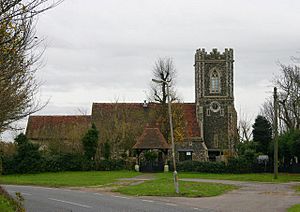St James' Church, West Tilbury facts for kids
Quick facts for kids Church of St James |
|
|---|---|
 |
|
| 51°28′25″N 0°23′26″E / 51.473739°N 0.390639°E | |
| Location | Church Road West Tilbury, Essex, RM16 4DJ |
| Country | England |
| Previous denomination | Church of England |
| History | |
| Status | Redundant |
| Architecture | |
| Heritage designation | Grade II* listed |
The Church of St James in West Tilbury is a very old building. It used to be a church and is now a private home. It's considered a special historical building, known as "Grade II* listed." The church was built using stones like flint and rubble. It was later repaired by someone named W Benton. Inside, you can still see parts of windows from the early Norman times. There's also a fancy memorial for Lady Gordon and her husband, Sir Adam Gordon, who was the rector (a type of priest) there from 1796 to 1817.
Contents
History of the Building
The Church of St James stopped being a church in 1979. In 1984, the Queen officially agreed that it was no longer needed as a church. After that, the building was changed into a private house. Some parts of the old burial ground became a garden for the home.
Inside, you can still find old memorial stones on the floor. There are also plaques on the walls. These plaques remember 14 people from the area who died serving in the armed forces. They fought in World War I (1914–1919) and World War II (1939–1945). The five bells that were in the church were moved. They were given to other churches in the area.
How the Church Was Built
The church building was first built a very long time ago. This was in the late 11th or early 12th century. It was made from local flint stones and other types of limestone. There used to be a north aisle, which is a side section of the church. This part was removed in the early 1700s. Only one piece was kept and used as a porch.
The church also had a stone tower and a pointed spire. A map from 1584 shows this tower. It was very important for sailors on the river. They used it as a landmark to help guide their ships. This helped them avoid dangerous shallow areas in the water.
The Great Storm of 1703
In November 1703, a huge storm hit. This storm might have damaged the church. In February 1711, the main part of the church, called the nave, suddenly fell down. The pillars and some outside walls collapsed.
People then started a country-wide appeal to raise money. This was called a "brief." Around 1712 or 1713, the local priest, William Philps, began rebuilding the church. It was estimated to cost about £1,117. The chancel, another part of the church, was not as badly damaged. But the nave needed a lot of repair. The old stone tower, which was a landmark for sailors, was completely replaced. A new tower was built from wood and plaster. This new tower held the five church bells.
At this time, people called St James' Church the "garrison church." This was because it was near Tilbury Fort, a military base. In the early 1800s, a wooden gallery was added inside the church. This gallery was specifically for the soldiers. Records from 1851 show that this gallery was still there.
Later Changes and Famous People
In 1879, a big restoration project began. This was part of a larger movement to update old English churches. The work lasted for four years. It was managed by W Benton. The tower was completely rebuilt using flint and stone. A clock was added to the tower. However, the spire, which had been there for centuries, was not put back. This final part of the restoration was finished in 1883. It was done in memory of James Burness, who owned the land in West Tilbury.
Well-Known People Connected to St James
One famous person who used to be a priest at St James' Church was William Laud. He later became the Archbishop of Canterbury, a very important leader in the Church of England.

